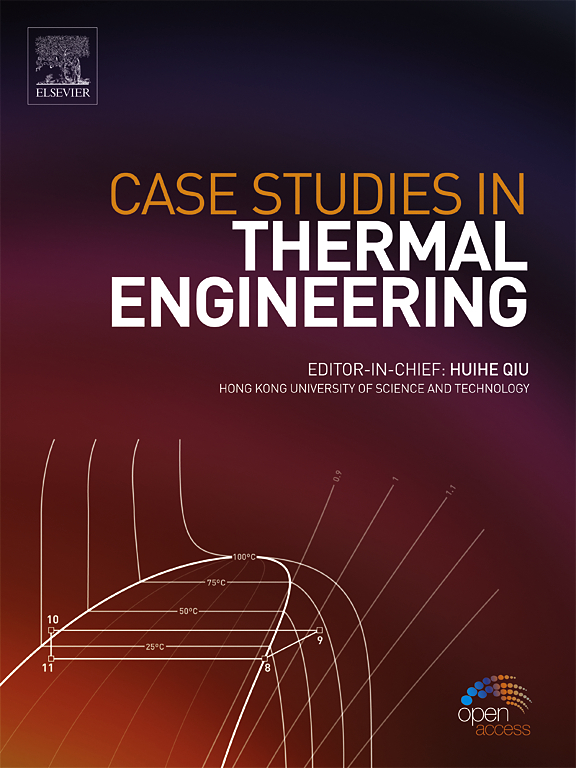Computational analysis of heat transport dynamics in viscous dissipative blood flow within a cylindrical shape artery through influence of autocatalysis and magnetic field orentation
IF 6.4
2区 工程技术
Q1 THERMODYNAMICS
引用次数: 0
Abstract
Nanofluids consisting of tetra nanoparticles are crucial in bio medical sciences due to their improved thermal transport characteristics. The advanced tailored properties of tera nanoparticles make them useful in several medical interventions, such as hyperthermia treatment, where the targeted tissue can be heated more efficiently, leading to better treatment outcomes. The current study investigates the heat transfer enhancement in a hemodynamic system using tetra nanoparticles. The physical configuration of the blood flow is assumed with in a permeable cylindrical shape stenosed artery. The model incorporates the Carreau model with inclusion of diverse factors such as, exponential space-based heat source, viscous dissipation, infinite shear rate and permeability of surface. Additionally, impact of chemical reaction (autocatalysis) and magnetohydrodynamic (MHD) consequences is also integrated into the system. The framed partial differential equations (PDEs) generated by physical problem are converted into new dimensionless form of an ordinary differential system (ODEs). Bvp4c MATLAB procedure is fetched for numerical investigation. It is observed that, velocity profile of the fluid is reduced due to intensification in inclined magnetic effect, whereas autocatalysis effect promotes the concentration of nanoparticles in blood flow mixture, which increases the temperature field of fluid. Furthermore, augmentation in the values of Wassenberg number increased the elasticity in blood which enables it to deform and stretch more readily in reaction to alterations in flow conditions and hence reduction is seen in overall blood flow rate. The results revealed the significance of these integrated factors for accurate modelling of blood flow passing through a stenosed artery, which is crucial in medical interventions.
圆柱形动脉内粘性耗散血流受自催化和磁场作用影响的热传输动力学计算分析
由四纳米粒子组成的纳米流体具有更好的热传输特性,因此在生物医学领域至关重要。四纳米粒子的先进定制特性使其在热疗等多种医疗干预中大显身手,可以更有效地加热目标组织,从而获得更好的治疗效果。目前的研究调查了四纳米粒子在血液动力学系统中的热传导增强作用。血流的物理结构假定是在可渗透的圆柱形狭窄动脉中。该模型采用了 Carreau 模型,并加入了多种因素,如指数空间热源、粘性耗散、无限剪切速率和表面渗透性。此外,化学反应(自催化)和磁流体力学(MHD)后果的影响也被纳入系统。由物理问题产生的框架偏微分方程 (PDE) 被转换成新的无量纲形式的常微分方程系统 (ODE)。采用 Bvp4c MATLAB 程序进行数值研究。结果表明,由于倾斜磁效应增强,流体的速度曲线减小,而自催化作用促进了血流混合物中纳米粒子的浓度,从而增加了流体的温度场。此外,瓦森伯格数值的增加提高了血液的弹性,使其在流动条件发生变化时更容易变形和拉伸,从而降低了总体血流量。研究结果表明,这些综合因素对于准确模拟通过狭窄动脉的血流具有重要意义,这在医疗干预中至关重要。
本文章由计算机程序翻译,如有差异,请以英文原文为准。
求助全文
约1分钟内获得全文
求助全文
来源期刊

Case Studies in Thermal Engineering
Chemical Engineering-Fluid Flow and Transfer Processes
CiteScore
8.60
自引率
11.80%
发文量
812
审稿时长
76 days
期刊介绍:
Case Studies in Thermal Engineering provides a forum for the rapid publication of short, structured Case Studies in Thermal Engineering and related Short Communications. It provides an essential compendium of case studies for researchers and practitioners in the field of thermal engineering and others who are interested in aspects of thermal engineering cases that could affect other engineering processes. The journal not only publishes new and novel case studies, but also provides a forum for the publication of high quality descriptions of classic thermal engineering problems. The scope of the journal includes case studies of thermal engineering problems in components, devices and systems using existing experimental and numerical techniques in the areas of mechanical, aerospace, chemical, medical, thermal management for electronics, heat exchangers, regeneration, solar thermal energy, thermal storage, building energy conservation, and power generation. Case studies of thermal problems in other areas will also be considered.
 求助内容:
求助内容: 应助结果提醒方式:
应助结果提醒方式:


